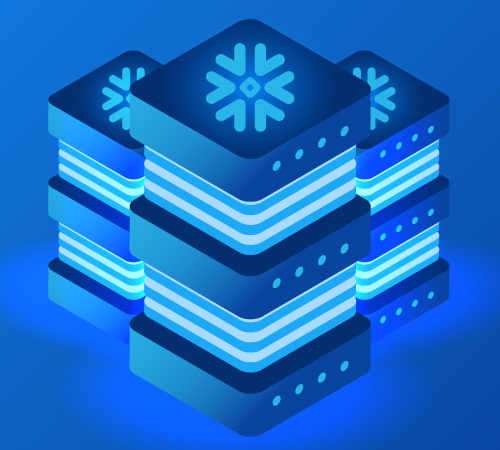Snowflake architectural layers include storage, computing, and cloud services, where data fetching, processing, and cleaning occur. In the data-driven world, enterprises produce a large amount of data that should be analyzed to make better business decisions. Snowflake, a cloud-based data storage solution, has a unique architecture that makes it one of the best data warehousing solutions for small and large enterprises.
The Snowflake data warehouse is a hybrid model amalgamation of traditional shared-disk and shared-nothing architecture. It uses a central data repository for persisted data, ensuring the information is accessible to the teams from all compute nodes. This ultimate guide will discuss the three Snowflake architectural layers in detail and how each layer functions to store, process, analyze, and clean stored data.
3 Key Snowflake Architectural Layers
As it is designed “in and for the cloud,” Snowflake is a data platform used both as a data lake as well as a data warehouse. Snowflake data warehousing solution eliminates the need for two applications and reduces the workload on the business team. In addition, organizations can scale up and down depending on their computing needs due to the high scalability of the platform. Below we will understand the Snowflake Storage layers briefly.
-
Storage Layer
Snowflake internally optimizes and compresses data after organizing it into multiple micro partitions. All the data in the organization is stored in the cloud, simplifying the business team’s data management process. It works as a shared-disk model, ensuring that the data team does not have to deal with data distribution across multiple nodes.
Compute layers connect with the storage layer, and the data is fetched to process the query. The advantage of the Snowflake storage layer is that enterprises pay for the monthly storage used (average) rather than a fixed amount.
-
Compute Layer
Snowflake uses virtual warehouse — MPP (massively parallel processing) compute clusters that consist of multiple nodes with Memory and CPU — to run queries. The data warehouse solution separates the query processing layer from the disk storage.
In addition, the virtual warehouse has an independent compute cluster. That said, it doesn’t interact with other virtual warehouses. As a virtual warehouse, data experts can start, stop, or scale it anytime without impacting the other running queries.
-
Cloud Service Layer
The cloud service layer is the last yet most essential Snowflake architectural layer among the three. All the critical data-related activities, such as security, metadata management, authentication, query optimization, etc., are conducted in the cloud service layer.
Whenever a user submits a query to Snowflake, it is sent to the query optimizer and compute layer for processing. In addition, metadata required for data filtering or query optimization takes place in the cloud services layer.
All three Snowflake architectural layers scale independently, and users can pay separately for the virtual warehouse and storage.
Inferenz data migration experts understand the ins and outs of Snowflake architectural layers and how to migrate data from traditional databases to modern data cloud systems. We have helped a US-based eCommerce company with data engineering and predictive analytics solutions that involved Snowflake implementation. Read the case study here.
Understanding Snowflake Data Architecture Layers & Process
According to IDC (International Data Centre), the world’s big data is expected to grow to 175ZB by 2025, at a CAGR of 61%. This massive growth in business data opens opportunities for adopting cloud-based data storage solutions. In the hyper-competitive era, enterprises store data in disparate sources, such as Excel, SQL Server, Oracle, etc.
Analyzing, processing, and cleaning information from different data sources is a challenge for in-house teams. This is where Snowflake helps the teams by being a single data source. Below we have mentioned a few steps that will help enterprises and teams understand the exact process of Snowflake.
-
Data Acquisition
The initial step is to collect data from various sources such as data lake, streaming sources, data files, data sharing, on-premise databases, and SAS and data applications. Then, all the business data is extracted/fetched and loaded into the Snowflake data warehouse. Finally, ETL tools extract and convert data into readable formats and store them in the Snowflake warehouse for the next step.
-
Data Cleaning & Processing
After the data is ingested into the Snowflake, different processes like cleaning, integration, enrichment, and modeling occur. Next, all the acquired data is thoroughly analyzed and cleaned by removing the repetitive and unstructured data. Lastly, information is governed, secured, and monitored to ensure business teams access structured and accurate data to make strategic business decisions.
-
Data Consumers
The cleaned data is then available for the teams for further action. Using business intelligence solutions and data science technologies, they can use the data to accelerate business growth.
ALSO READ: Data Cleansing: What Is It & Why It Matters?
Switch To Snowflake Data Warehouse With Inferenz
Cloud data platforms such as Snowflake are high-performing and cost-effective data storage solutions for any enterprise that uses big data to make strategic decisions. Snowflake architectural layers and hybrid model make the platform a secure, scalable, and pocket-friendly solution to all data storing needs.
Inferenz, a company with certified data migration experts, can help you learn more about the concept and migrate from on-premise solutions to cloud-based data-storing applications. The experts of Inferenz will help you understand Snowflake architectural layers and transfer data from one repository to another without data breach threats.




